Audio And Visual System (W/ Multi-Display) -- System Description |
| DISC PLAYER OUTLINE |
A disc player uses a laser pickup to read digital signals recorded on a disc. By converting the digital signals to analog, it can play music, video and audio.
- CAUTION:
- Do not look directly at the laser pickup because the disc player uses an invisible laser beam. Be sure to operate the player only as instructed.
- NOTICE:
- Do not disassemble any part of the disc player.
- Do not apply oil to the disc player.
- Do not insert anything but a disc into the disc player.
This player can play only audio CDs, CD-Rs (CD-Recordable) and CD-RWs (CD-ReWritable) that have any of the following marks:

This player can play only DVD videos that have any of the following marks:

This player can play only DVD-Rs (DVD-Recordable) and DVD-RWs (DVD-ReWritable) that were recorded in video format and that have any of the following marks:

The following products may not be playable on your player.
- SACD
- DTS CD
- Copy-protected CD
- Super Video CD
- DVD audio
- DVD-RAM
- SACD
Precautions for use of discs
- NOTICE:
- CD-Rs and CD-RWs may not be played depending on the recording conditions or characteristics of the discs, or due to damage, dirt or deterioration caused by leaving the discs in the cabin for a long time.
- Unfinalized CD-Rs and CD-RWs cannot be played.
- CD-Rs and CD-RWs are more easily affected by a hot and humid environment than discs used for normal audio CDs. For this reason, some CD-Rs and CD-RWs may not play.
- If there are fingerprints or scratches on a disc, the disc may not play or the disc may skip.
- Some CD-Rs and CD-RWs may deteriorate if they are left in the cabin for a long time.
- Keep CD-Rs and CD-RWs in an opaque case.
- DualDiscs that mate DVD recorded material on one side with CD digital audio material on the other cannot be played.
- Keep the discs away from dirt. Be careful not to damage the discs or leave fingerprints on them.
- Hold discs by the outer edge and center hole with the label side up.
- Leaving the disc exposed halfway out of the slot for a long time after pressing the disc eject button may cause deformation of the disc, making the disc unusable.
- If discs have adhesive tape, stickers, disc labels or any traces of such labels attached, the discs may not be ejected or player malfunctions may result.
- Keep the discs away from direct sunlight. (Exposure to direct sunlight may cause deformation of the disc, making the disc unusable.)
- Do not use odd-shaped disc because these may cause player malfunctions.
- Do not use discs whose recording portion is transparent or translucent because they may not be inserted, ejected or played normally.
- Use only 4.7 in. (12 cm) disc.
- Do not use 3 in. (8 cm) CDs either with or without adaptors.
- HINT:
- When it is cold or raining, if the windows fog up, mist and condensation may form in the player. In such cases, the disc may skip or stop in the middle of play. Ventilate or dehumidify the cabin for a while before using the player.
- The disc may skip if the player experiences strong vibrations when the vehicle is driven on rough roads or similar uneven surfaces.
Cleaning
- NOTICE:
- Do not use a lens cleaner because it may cause a malfunction in the pickup portion of the player.
If dirt is on the disc surface, wipe it clean with a soft dry cloth such as an eyeglass cleaner for plastic lenses from the inside to the outside in a radial direction.
- NOTICE:
- Pressing on the disc by hand or rubbing the disc with a hard cloth may scratch the disc surface.
- Use of solvents such as record spray, antistatic agents, alcohol, benzine, thinners or a chemical cloth may cause damage to the disc, making the disc unusable.
 |
| MP3/WMA/AAC OUTLINE |
Playable MP3 file standards
Compatible standard MPEG1 LAYER3, MPEG2 LSF LAYER3 Compatible sampling frequency - MPEG1 LAYER3: 32, 44.1, 48 (kHz)
- MPEG2 LSF LAYER3: 16, 22.05, 24 (kHz)
Compatible bit rate - MPEG1 LAYER3: 32 to 320 (kbps)
- MPEG2 LSF LAYER3: 8 to 160 (kbps)
- Compatible with VBR
Compatible channel mode Stereo, joint stereo, dual channel, monaural - MPEG1 LAYER3: 32, 44.1, 48 (kHz)
Playable WMA file standards
Compatible standard WMA Ver. 7, 8 and 9 Compatible sampling frequency 32, 44.1, 48 (kHz) Compatible bit rate (Only compatible with 2-channel playback) - Ver. 7, 8: CBR48 to 192 (kbps)
- Ver. 9: CBR48 to 320 (kbps)
- Compatible with VBR
- Ver. 7, 8: CBR48 to 192 (kbps)
Playable AAC file standards
Compatible standard MPEG4/AAC-LC Compatible sampling frequency 11.025, 12, 16, 22.05, 24, 32, 44.1, 48 (kHz) Compatible bit rate - 16 to 320 (kbps)
- Compatible with VBR
- 16 to 320 (kbps)
ID3 tag, WMA tag and AAC tag
Additional text information called an ID3 tag can be input to MP3 files. Information such as song titles and artist names can be stored.
- HINT:
- This player is compatible with ID3 tags of ID3 Ver. 1.0 and 1.1 and ID3 Ver. 2.2 and 2.3. (Number of characters complies with ID3 Ver. 1.0 and 1.1.)
Additional text information called a WMA tag can be input to WMA files. Information such as song titles and artist names can be stored.
Additional text information called an AAC tag can be input to AAC files. Information such as song titles and artist names can be stored.
Usable media
Only CD-ROMs, CD-Rs (CD-Recordable), CD-RWs (CD-ReWritable) and USB device can be used to play MP3/WMA/AAC files.
- NOTICE:
- CD-Rs and CD-RWs are more easily affected by a hot and humid environment than discs used for normal audio CDs. For this reason, some CD-Rs and CD-RWs may not play.
- If there are fingerprints or scratches on a disc, the disc may not play or the CD may skip.
- Some CD-Rs and CD-RWs may deteriorate if they are left in the cabin for a long time.
- Keep CD-Rs and CD-RWs in an opaque case.
Usable media format
Usable media format
Disc format CD-ROM Mode 1, CD-ROM XA Mode 2 Form 1, DVD-ROM File format ISO9660 Level 1 and Level 2 (Joliet, Romeo) - HINT:
- MP3/WMA/AAC files written in any unlisted format may not be played normally or the file names or folder names may not be displayed correctly.
- This player is compatible with multi-session discs and can play CD-Rs and CD-RWs on which MP3/WMA/AAC files have been added. However, only the first session can be played.
- Discs whose first session includes both music data and MP3, WMA and AAC format data cannot be played.
Standards and restrictions
Maximum directory levels 8 levels Maximum number of characters for a folder name/file name 32 characters Maximum number of folders 192 (Including empty folders, root folders and folders that do not contain MP3/WMA/AAC files) Maximum number of files in a disc 255 (Including non- MP3/WMA/AAC files)
File names
Only files with an extension of ".mp3", ".wma" and ".m4a" can be recognized and played as MP3, WMA or AAC files.
Save MP3, WMA or AAC files with an extension of ".mp3", ".wma" or ".m4a".
- NOTICE:
- If non-MP3, non-WMA or non-AAC files are saved with an extension of ".mp3", ".wma" or ".m4a", those files may be wrongly recognized as MP3, WMA or AAC files and played. A loud noise may occur and damage to the speakers may result.
| "Bluetooth" OUTLINE |
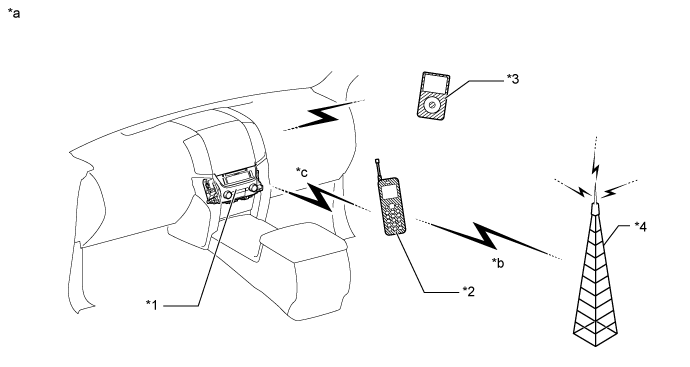
| *1 | Multi-media Module Receiver Assembly (Built-in "Bluetooth" receiver antenna) | *2 | Cellular Phone ("Bluetooth" compatible type) |
| *3 | Portable Audio Player ("Bluetooth" compatible type) | *4 | Cellular Tower |
| *a | Example | *b | Cellular Network |
| *c | "Bluetooth" Wireless Connection | - | - |
"Bluetooth" is a trademark owned by Bluetooth SIG, Inc.
"Bluetooth" is a wireless connection technology that uses the 2.4 GHz frequency band.
- HINT:
- The communication performance of "Bluetooth" may vary depending on obstructions or radio wave conditions between communication devices, electromagnetic radiation, communication device sensitivity or antenna capacity.
Hands-free function
The "Bluetooth" built-in multi-media module receiver assembly and a "Bluetooth" compatible cellular phone* can be connected using a "Bluetooth" wireless connection. This enables the use of the hands-free function on the cellular phone even if the phone is in a pocket or bag. For this reason, it is not necessary to use a connector or cable to connect the cellular phone.
*: Some versions of "Bluetooth" compatible cellular phones may not function.Compatible hands-free devices
Required "Bluetooth" specifications Ver. 2.0 + EDR or higher (Ver. 3.0 or higher recommended) Compatible profiles - HFP (Hands Free Profile) Ver. 1.0 or higher (Ver. 1.6 or higher recommended)*1
- OPP (Object Push Profile) Ver. 1.1 or higher (Ver. 1.2 or higher recommended)*1
- PBAP (Phone Book Access Profile) Ver. 1.0 or higher (Ver. 1.1 or higher recommended)*1
- MAP (Message Access Profile) Ver. 1.0 or higher*2
- SPP (Serial Port Profile) Ver. 1.1 or higher*3
- DUN (Dial-Up Networking Profile) Ver. 1.1 or higher*4
Maximum number of hands-free devices that can be registered (including audio devices) 5 - *1: This profile is necessary when using the hands-free function.
- *2: This profile is necessary when using the message function (w/ SMS/MMS/e-mail Function).
- *3: This profile is necessary when using the Toyota Link function (w/ Toyota Link Function).
- *4: This profile is necessary when using the telematics system (w/ Telematics System).
- HINT:
- The amount of remaining battery charge displayed on the multi-media module receiver assembly may be different from that of the "Bluetooth" device.
- HFP (Hands Free Profile) Ver. 1.0 or higher (Ver. 1.6 or higher recommended)*1
"Bluetooth" audio function
The "Bluetooth" built-in multi-media module receiver assembly and a "Bluetooth" compatible portable audio player* can be connected using a "Bluetooth" wireless connection. This enables files stored in the portable audio player to be heard from the vehicle speakers. In addition, operations such as play/stop can be performed directly from the multi-media module receiver assembly.
*: Some versions of "Bluetooth" compatible audio players may not be able to operate the "Bluetooth" function, or music may play, but functions available using the multi-media module receiver assembly may be limited.Compatible "Bluetooth" audio devices
Required "Bluetooth" specifications Ver. 2.0 + EDR or higher (Ver. 3.0 or higher recommended) Compatible profiles - A2DP (Advanced Audio Distribution Profile) Ver. 1.0 or higher (Ver. 1.2 or higher recommended)
- AVRCP (Audio/Video Remote Control Profile) Ver. 1.0 or higher (Ver. 1.4 or higher recommended)
Maximum number of audio devices that can be registered (including hands-free devices) 5 - HINT:
- The amount of remaining battery charge displayed on the multi-media module receiver assembly may be different from that of the "Bluetooth" device.
- A2DP (Advanced Audio Distribution Profile) Ver. 1.0 or higher (Ver. 1.2 or higher recommended)
| RADIO DESCRIPTION |
Radio frequency band
Radio broadcasts use the radio frequency bands shown in the table below.
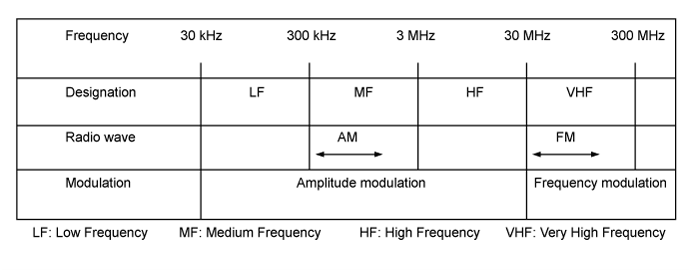
Service area
The service areas of AM and FM broadcasts are vastly different. Sometimes an AM broadcast can be received very clearly but an FM stereo broadcast cannot. FM stereo has the smallest service area and is prone to pick up static and other types of interference such as noise.
Text in Illustration *a FM (Stereo) *b FM (Monaural) *c AM

Radio reception problems
- HINT:
- In addition to static, other problems such as "phasing", "multipath" and "fade out" exist. These problems are not caused by electrical noise, but by the radio signal propagation method itself.
Phasing
AM broadcasts are susceptible to electrical interference and another kind of interference called phasing. Occurring only at night, phasing is the interference created when a vehicle receives 2 radio wave signals from the same transmitter. One signal is reflected off the ionosphere and the other signal is received directly from the transmitter.Text in Illustration *a Phasing *b Ionosphere Multipath
Multipath is a type of interference created when a vehicle receives 2 radio wave signals from the same transmitter. One signal is reflected off buildings or mountains and the other signal is received directly from the transmitter.Text in Illustration *a Multipath Fade out
Fade out is caused by objects (buildings, mountains and other such large obstacles) that deflect away part of a signal, resulting in a weaker signal when the object is between the transmitter and vehicle. High frequency radio waves, such as FM broadcasts, are easily deflected by obstructions. Low frequency radio waves, such as AM broadcasts, are less likely to deflect.Text in Illustration *a Fade Out
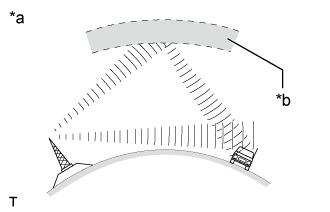
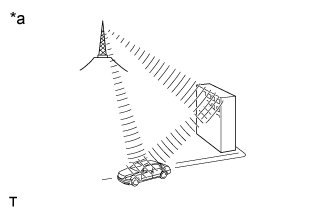
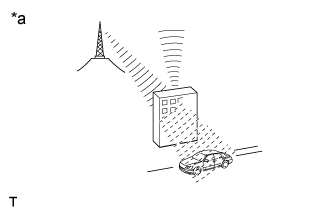
Noise problem
Technicians must have a clear understanding about each customer's noise complaint. Use the following table to diagnose noise problems.Radio Frequency Noise Occurrence Condition Presumable Cause AM Noise occurs in a specific area Foreign noise Noise occurs when listening to an intermittent broadcast An identical program transmitted from multiple towers can cause noise where the signals overlap Noise occurs only at night Signal phasing FM Noise occurs while driving in a specified area Multipath resulting from a change in FM frequency
| DIGITAL AUDIO BROADCAST (DAB) FUNCTION OUTLINE (w/ DAB Function) |
Digital Audio Broadcast (DAB) is the standard for digital radio. Compared to conventional FM/AM broadcasting, DAB enables higher sound quality radio broadcasting with lower noise when reception conditions change. DAB has an FM-link function that automatically and temporarily changes to the simultaneously broadcasted FM station when the DAB broadcasting reception level falls.
| RDS-TMC FUNCTION OUTLINE (w/ RDS-TMC Function) |
This system has a function which allows the reception of traffic information from Radio Data System Traffic Message Channel (RDS-TMC) stations based on FM-multiple broadcasting. It assists the driver to avoid areas with traffic congestion. It also helps to improve traffic flow and road safety (Click here).
| RBDS FUNCTION OUTLINE |
The Radio Broadcast Data System (RBDS) is broadcast through conventional FM radio broadcasts. Information such as song names, traffic information, broadcast station names, etc. can be received.
| TOYOTA LINK FUNCTION OUTLINE (w/ Toyota Link Function) |
Enables the usable content of a cellular phone to be displayed on and operated from the multi-display assembly screen. As "Bluetooth" communication is used for the communication between a cellular phone and the multi-media module receiver assembly, before using the Toyota Link function on the audio and visual system, the cellular phone needs to be registered with the audio and visual system as a "Bluetooth" device. For details regarding Toyota Link, applications and compatible phones, refer to http:// www.toyota.com.au/.
| SOUND LIBRARY FUNCTION OUTLINE (w/ Sound Library Function) |
Approximately 3000 tracks with a 5-minute track length average can be recorded to the HDD from audio discs using AAC encoding at 128 kbps (a maximum of 9999 tracks can be recorded if tracks with an average track length of less than 5 minutes are recorded or the tracks are encoded at less than 128 kbps).
Album, artist, genre and title names for recorded tracks can be input or edited freely.
These names make it possible to search for a track easily.
- HINT:
- Recording equipment should be used only for lawful copying. It is necessary to carefully confirm what is lawful copying in the country in which you are making a copy.
- Copying of copyright material such as films or music is unlawful unless permitted by a legal exception or consent granted by the owners of the rights to the content.
| VEHICLE CUSTOMIZATION OUTLINE |
Customization of functions can also be customized on the multi-display assembly screen. Refer to Owner's Manual for further information on customizable items for the audio and visual system.
- HINT:
- Items available for customization via the audio and visual system can also be customized by using the GTS.
- Some customize parameters displayed on the GTS will be displayed on the "Vehicle Customization" screen for the audio and visual system. Users can customize these items.
| USB FUNCTION OUTLINE |
The No. 1 stereo jack adapter assembly is equipped with a USB terminal. Connecting a USB memory device or "iPod" to the No. 1 stereo jack adapter assembly allows compatible files to be played. Not only it is possible to play music from a USB memory device with audio functions, is also possible to play compatible music files that are stored on a USB memory. Also, the "iPod" control software is installed on the multi-media module receiver assembly, allowing song selection from the list, switching of the shuffle mode, operation of the "iPod" video, etc., from the multi-display assembly screen.
- HINT:
- Operation through the controls of a USB device or "iPod" cannot be performed while it is connected.
Playable music files
Playable music file standards are equivalent with the standards of the music files that can be played on the disc player.
Playable video files
Playable video file standards
MPEG4 Compatible file extensions .mp4, .m4v Compatible video standards H. 264 (AVC), MPEG4 Compatible audio standards AAC Compatible image size 1920 X 1080 or less Compatible frame rate 60i/30p or less AVI Compatible file extensions .avi Compatible video standards H. 264 (AVC), MPEG4 Compatible audio standards AAC Compatible image size 1920 X 1080 or less Compatible frame rate 60i/30p or less WMV Compatible file extensions .wmv Compatible video standards WMV9, WMV9 Advanced Profile Compatible audio standards WMA 7 8 9(9.1 9.2) Compatible image size 1920 X 1080 or less Compatible frame rate 60i/30p or less
USB audio system compatible devices
USB device
The following device formats can be used:
MP3, WMA, AAC, MP4, WMV and AVI files written in any format other than those listed above may not play correctly and their names and folder names may not be displayed correctly.Compatible USB device formats - USB communication format: USB 2.0 HS (480 Mbps) and FS (12 Mbps)
- File format: FAT16/32 (Windows)
- Class: Mass storage class, HID, audio, HUB, CDC etc.
Items related to standards and limitations are as follows:- Maximum directory hierarchy: 9 levels or higher
- Maximum number of folders in device: 3000 (including the root folder)
- Maximum number of files in device: 9999
- Maximum number of files per folder: 255
- USB communication format: USB 2.0 HS (480 Mbps) and FS (12 Mbps)
"iPod"
"iPhone", "iPod", "iPod classic", "iPod nano" and "iPod touch" are trademarks of Apple Inc., registered in the U.S. and other countries.
The following "iPod", "iPod nano", "iPod classic", "iPod touch" and "iPhone" devices can be used with this system.
Made for:- "iPod touch" (5th generation)
- "iPod touch" (4th generation)
- "iPod touch" (3rd generation)
- "iPod touch" (2nd generation)
- "iPod touch" (1st generation)
- "iPod classic"
- "iPod with video"
- "iPod nano" (7th generation)
- "iPod nano" (6th generation)
- "iPod nano" (5th generation)
- "iPod nano" (4th generation)
- "iPod nano" (3rd generation)
- "iPod nano" (2nd generation)
- "iPod nano" (1st generation)
- "iPhone 5"
- "iPhone 4S"
- "iPhone 4"
- "iPhone 3GS"
- "iPhone 3G"
- "iPhone"
- HINT:
- Depending on differences between models or software versions etc., some models might be incompatible with this system.
- "iPod touch" (5th generation), "iPod nano" (7th generation) and "iPhone 5" screens cannot be displayed in iPod-video mode on the multi-media module receiver assembly.
- "iPod touch" (5th generation)
| CUSTOMIZE STARTUP IMAGE OR SCREEN OFF IMAGE FUNCTION OUTLINE |
An image can be copied from a USB device. The image can be used as the startup image or screen off image of the audio and visual system.
| AUTOMATIC SOUND LEVELIZER (ASL) FUNCTION OUTLINE |
The Automatic Sound Levelizer (ASL) function automatically adjusts the audio system volume level in order to compensate for increased vehicle noise (vehicle noise tends to increase as vehicle speed increases). The ASL adjusts the volume level based upon vehicle speed signals that it receives from the combination meter assembly.
| DIAGNOSTIC FUNCTION OUTLINE |
The audio and visual system has a diagnostic function (the result is indicated on the master unit).
| "Wi-Fi" OUTLINE (w/ "Wi-Fi" Function) |
"Wi-Fi" is a worldwide wireless communication standard widely used as a short range communication tool.
"Wi-Fi" is a trademark owned by Wi-Fi Alliance, a non-profit industry association.
The multi-media module receiver assembly uses the 2.4 GHz frequency band for "Wi-Fi" communication.
- HINT:
- The communication performance of "Wi-Fi" may vary depending on obstructions or radio wave conditions between communication devices, electromagnetic radiation, communication device sensitivity or antenna capacity.
| COMMUNICATION SYSTEM |
MOST Network Outline
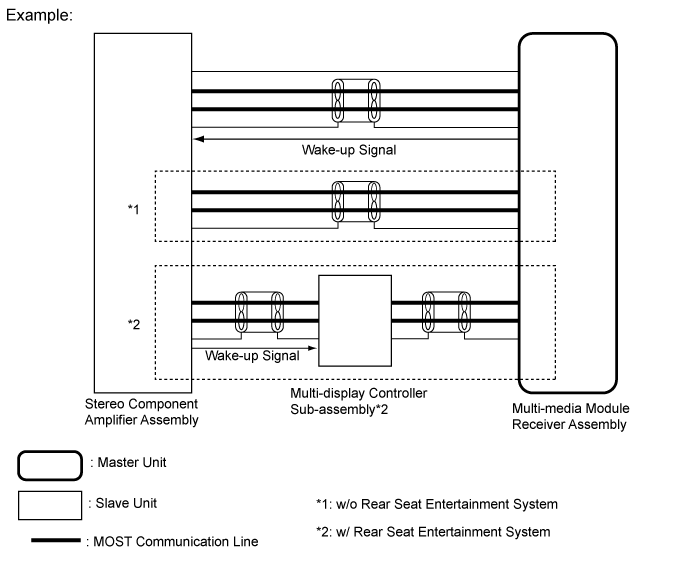
Audio and visual system components communicate with each other via the MOST network.
The MOST network uses a shielded twisted pair of wires for its communication lines.
The master unit of the MOST network is the multi-media module receiver assembly.
MOST communication lines connect each slave unit centering around the master unit to form a MOST network ring.
The master unit sends a wake-up signal to activate each slave unit connected to the MOST network.
- HINT:
- If a short or open circuit occurs in the MOST circuit, communication will be interrupted and the system will not operate normally.
AVC-LAN Outline
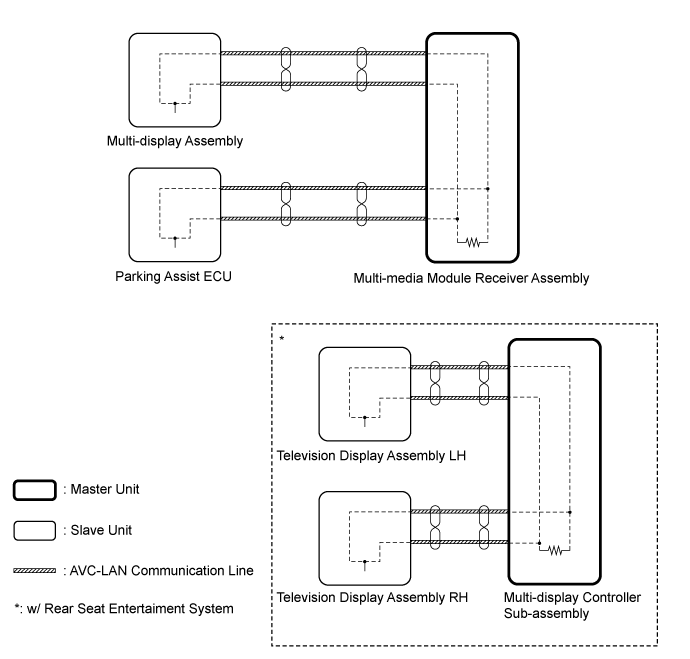
Components of the audio and visual system communicate with each other via the AVC-LAN.
The AVC-LAN uses a twisted pair of wires for its communication lines.
The master unit of the AVC-LAN is the multi-media module receiver assembly and multi-display controller sub-assembly.
- HINT:
- The multi-media module receiver assembly and multi-display controller sub-assembly has the resistance (60 to 80 Ω) necessary for communication.
- If a short or open circuit occurs in the AVC-LAN circuit, communication is interrupted and the system will not operate normally.
Local Bus Outline
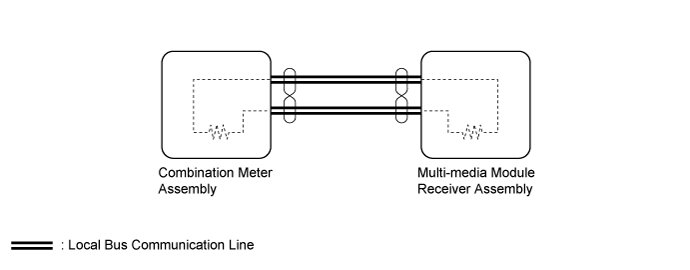
Components of the audio and visual system communicate with each other via the Local Bus.
The Local Bus uses a twisted pair of wires for its communication lines.
The master unit of the Local Bus is the multi-media module receiver assembly.
- HINT:
- The multi-media module receiver assembly has the resistance (108 to 132 Ω) necessary for communication.
- The combination meter assembly has the resistance (108 to 132 Ω) necessary for communication.
- If a short or open circuit occurs in the Local Bus circuit, communication is interrupted and the system will not operate normally.